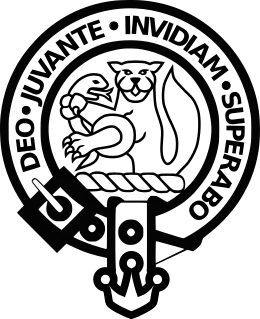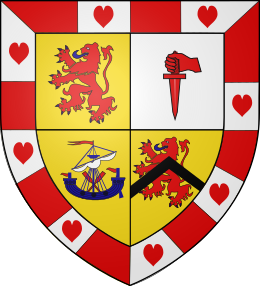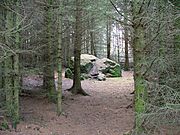Clan MacThomas facts for kids
Quick facts for kids Clan MacThomas |
|||
|---|---|---|---|

Crest: A demi-cat-a-mountain rampant guardant Proper, grasping in his dexter paw a serpent Vert, langued Gules, its tail environing the sinister paw
|
|||
| Motto | Deo juvante invidiam superabo (Latin: God help overcome envy) | ||
| Profile | |||
| Region | Highland | ||
| District | Perthshire | ||
| Chief | |||
 |
|||
| Andrew Patrick MacThomas of Finegand, | |||
| The Chief of Clan MacThomas. (MacThomaidh Mhor.) | |||
|
|||
|
|||
Clan MacThomas is a proud Scottish clan from the Scottish Highlands. They are part of a larger group called the Clan Chattan. The clan has a rich history, with its roots in the beautiful mountains and glens of Scotland.
Contents
History of Clan MacThomas
How the Clan Began
The Clan MacThomas started with a man named Thomas. He spoke Scottish Gaelic and was known as Tomaidh Mòr. The clan gets its name from him. Thomas lived in the 1400s. He was the grandson of William Mackintosh, a powerful chief.
At that time, the Clan Chattan was very big. It became hard to manage. So, Thomas led his clan from Badenoch to a new home. They traveled over the Grampian Mountains to Glen Shee. Here, the clan grew strong. Their name changed over time to sound like McComie, McColm, and McComas. These are all ways to say the Gaelic name. The government in Edinburgh knew them as Macthomas.
From the 1500s to the 1600s
The early chiefs of Clan MacThomas lived at a place called the Thom. This was near the Spittal of Glenshee. Around 1600, the fourth chief, Robert Mccomie, died. His brother, John Mccomie of Finegand, became the new chief.
The clan's main home moved to Finegand. This place is about three miles down the glen. Its name means "burn of the heads." This name comes from a story about tax collectors. Their heads were supposedly thrown into the stream.
The seventh chief was John Mccomie, also known as Iain Mòr. He was a famous figure in Perthshire stories. He often had problems with tax collectors. Once, a skilled swordsman from Italy was sent to fight him. But Iain Mòr won the fight.
During the Wars of the Three Kingdoms in the 1600s, Clan MacThomas supported King Charles I. Iain Mor MacThomas joined a leader named James Graham, 1st Marquess of Montrose in 1644. He helped capture a Covenanter leader in Aberdeen.
Later, Iain Mor stopped supporting Montrose. He focused on buying more land instead. He even bought the Barony of Forter.
After 1660, the MacThomas chief faced big fines. The Earl of Airlie tried to get back some land. The Earl won in court. But the MacThomas chief kept using the land. The Earl then leased the land to men from Clan Farquharson. This led to a conflict between the clans.
In 1673, a Farquharson leader was killed. Two of Iain Mor MacThomas's sons also died. The legal battles that followed cost the MacThomas chief a lot of money. When he died in 1676, his remaining sons had to sell their lands.
After this, the clan members began to spread out. Some moved south to the Tay valley. They became known as Thomson. Others went to Angus in Fife. There, they were called Thomas, Thom, or Thoms. The tenth chief took the name Thomas. He later changed it to Thoms. He became a successful farmer in northern Fife.
From the 1700s to Today
The chief's family moved to Fife. They became successful farmers. Later, they moved to Dundee. Here, they did well in property and insurance. Dundee was growing fast in the 1700s.
Other clan members moved to Aberdeenshire. One of them, William McCombie, became famous. He was an MP and bred special Aberdeen-Angus cattle.
Patrick, the 16th chief, became the Provost of Dundee in 1847. He bought the Aberlemno Estate. His son, George, became one of Scotland's youngest judges in 1870. When George died, he left his large fortune to St Magnus Cathedral in Orkney. He also left the Aberlemno Estate.
His heir, Alfred, the 17th chief, tried to challenge the will in court. But he lost the case in 1905.
In 1954, the Clan MacThomas Society was started. This was by Patrick, the 18th chief. He was married to a distant cousin of Queen Elizabeth II. His son, Andrew, is the 19th and current chief. He has worked hard for his clan. Now, when you visit Glenshee, you can clearly see the clan's history there.
Clan members from all over the world meet every three years. They gather at the clan's land, "Clach Na Coileach" (The Cockstane). This special place is in Glenshee. The next gathering will be in August 2023.
Clan Profile
Motto and Current Chief
- Clan Motto: Deo juvante invidiam superabo (Latin) (With God's help, I will overcome envy).
- Clan Chief: Andrew MacThomas of Finegand, 19th Chief of Clan MacThomas.
Clan Septs
These are some of the names linked to Clan MacThomas. They are recognized by the Clan MacThomas Society:
- Combie
- MacOmie
- MacOmish
- McColm
- McComas
- McCombe
- McComb
- McCombie
- McComie
- McComish
- Tam
- Thom
- Thoms
- Thomas
- Thomson
Remember: Mac and Mc mean the same thing and can be used interchangeably.
List of Clan Chiefs
| Chief | Name | Dates | Important Facts |
|---|---|---|---|
| 1st | Thomas (Tomaidh Mòr) | 15th century | The first chief, lived at the Thom. |
| 2nd | John MacThomaidh of the Thom | Early 16th century | Son or grandson of Tomaidh Mòr. |
| 3rd | Adam MacThomaidh of the Thom | mid-16th century | Son of John. |
| 4th | Robert MacThomaidh of the Thom | Died 1600 | The Thom was lost after his death. |
| 5th | John McComie of Finegand | 1600–1610 | Robert's brother; moved the clan's home to Finegand. |
| 6th | Alexander McComie of Finegand | 1610–1637 | Gained more land in Glenshee. |
| 7th | John McComie (Iain Mor) | 1637–1676 | Known as "McComie Mòr," he made the clan stronger and gained more land. He supported Montrose in 1644. |
| 8th | James McComie | 1674–1676 | Third son of Iain Mor. |
| 9th | Thomas McComie | 1676–1684 | Fifth son of Iain Mor. |
| 10th | Angus Thomas | 1684–1708 | Educated at St. Andrew University, he changed his last name to sound more English. |
| 11th | Robert Thomas | 1708–1740 | Son of Angus, owned a large estate. |
| 12th | David Thomas of Belhelvie | 1740–1751 | Eldest son of Robert, died young. |
| 13th | Henry Thomas of Belhelvie | 1751–1797 | Second son of Robert, continued farming. |
| 14th | William Thoms | 1797–1843 | Eldest son of Henry, became a merchant. He had no children. |
| 15th | Patrick Hunter MacThomas Thoms | 1843–1870 | Provost of Dundee, bought the Aberlemno Estate. |
| 16th | George Hunter MacThomas Thoms | 1870–1903 | Son of Patrick; a judge. He left his wealth to St. Magnus Cathedral. |
| 17th | Alfred MacThomas Thoms | 1903–1958 | A lawyer who challenged his father's will. |
| 18th | Patrick MacThomas of Finegand | 1958–1970 | An Army Officer, he was the first chief officially recognized by the Court of the Lord Lyon in a long time. He married a cousin of Queen Elizabeth II. |
| 19th | Andrew MacThomas of Finegand (MacThomaidh Mòr) | 1970-date | The current Clan Chief, a retired banker. |
See also



